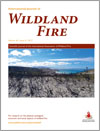International Journal of Wildland Fire
Volume 26
Number 6 2017
We identified strategies that reduced risk for both conservation and property. Increasing fuel treatment area in landscapes can be beneficial by reducing burn probability and wildfire extent. However, impact from exposure to fire remains high. Additional complementary strategies will provide further risk reduction benefits.
This paper examines relationships between wildfire knowledge and experience, preparedness and information seeking in selected southern California communities. Findings support using two-way communication from agencies for geographically specific risk threat, and event-based and readiness information, along with one-way sources like television, which can act as a link to interactive media.
We document regeneration 3 years after burning live and dead jack pine stands using different types of fire. Without fire, there was no regrowth of pine five summers after mortality. A higher percentage of cones were opened by fire in dead stands and continuous crown fire promoted pine seedlings in dead stands.
We evaluated the effect of fall and spring grazing on fuels, fire ignition and initial spread in shrub steppe communities. Both grazing treatments decreased fine fuels and increased fuel moisture and subsequently decreased the probability of fire ignition and initial spread. Effects, however, varied by grazing management.
Fire severity maps derived from satellite imagery and simulation modelling were compared with field data for a prescribed burn. Overall, the satellite-based map was more accurate than the modelled map, but both methods overestimated the area of unburnt forest. These methods provide viable approaches for mapping the severity of prescribed fires but need further refinement.
We examined the human and biophysical factors driving the regional distribution of wildfires in a Mediterranean area. We found a fire size-dependent pattern in which humans control the distribution of all fires whereas land cover and fire weather mainly explained the location of the largest fires. These factors should therefore be taken into consideration when projecting fire hazard.
Precipitation is a key component in fire danger prediction. Spatial interpolation of precipitation from sparse weather stations is a problem over large areas. A new precipitation analysis system that incorporates Doppler radar, weather station and forecast data was assessed and shown to improve precipitation estimation and resultant fire weather indices.
Wildfires are burning larger and hotter, with substantial impacts on forest wildlife. We review what is known about small-mammal responses to fire in North America; most studies focus only on changes in abundance between burned and mature forests. Our review highlights the need for more diverse research in study design and response variables to gain a richer understanding of small-mammal responses to fire.
Resprouting is a key trait that helps plants recover after fire. Our survey following an extensive fire on an island in Bass Strait found resprouting rates were low, even in species with the capacity to resprout. This shows that the dichotomisation of plant species as ‘resprouters’ or ‘non-resprouters’ is overly simplistic.
Straw mulch is commonly applied to reduce post-fire erosion, but can have non-target effects on plant communities. Our study documented higher non-native plant cover and richness in areas treated with rice straw mulch, with 25 non-native species exclusive to mulched areas. Total plant cover and conifer regeneration were relatively unaffected.




